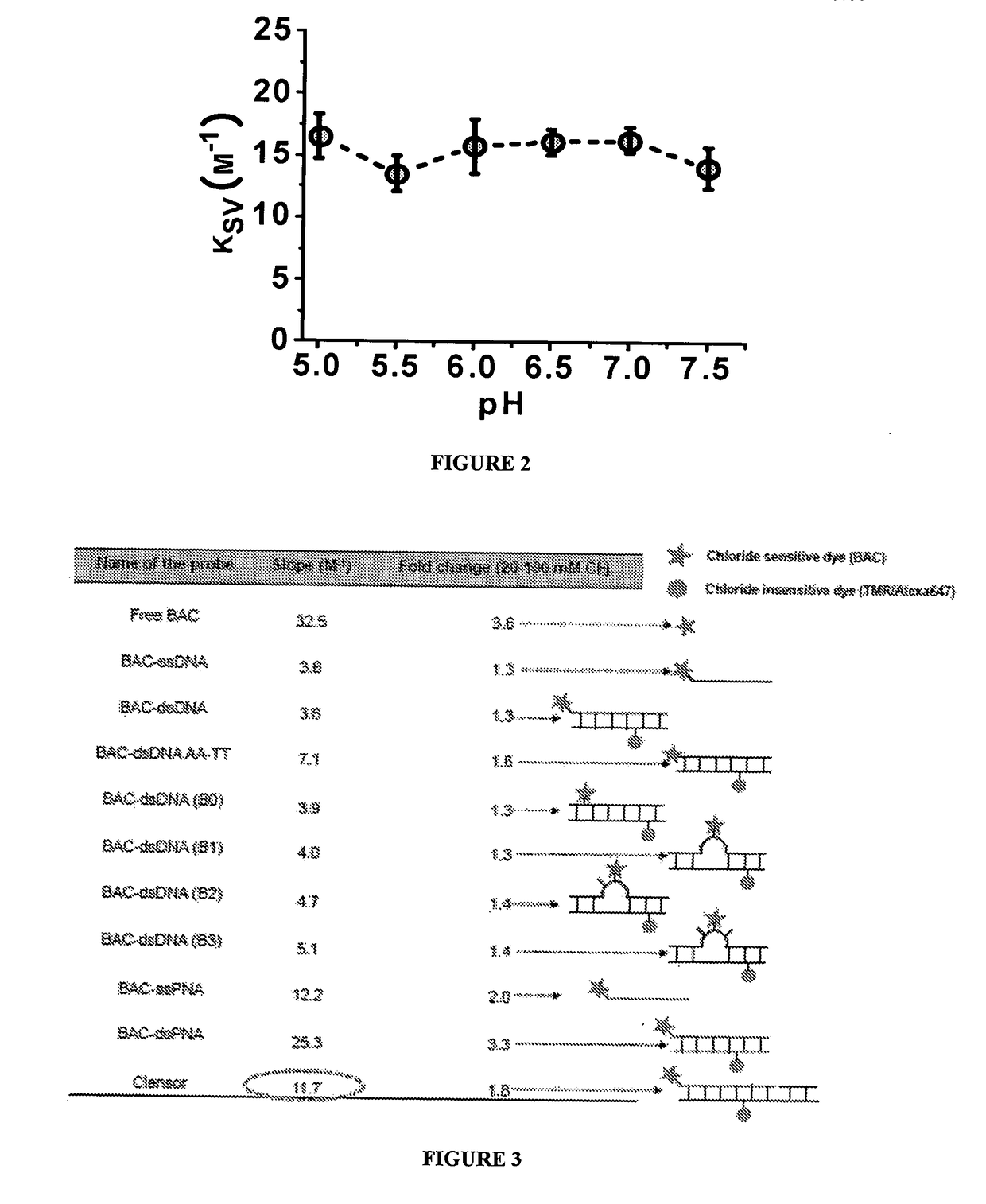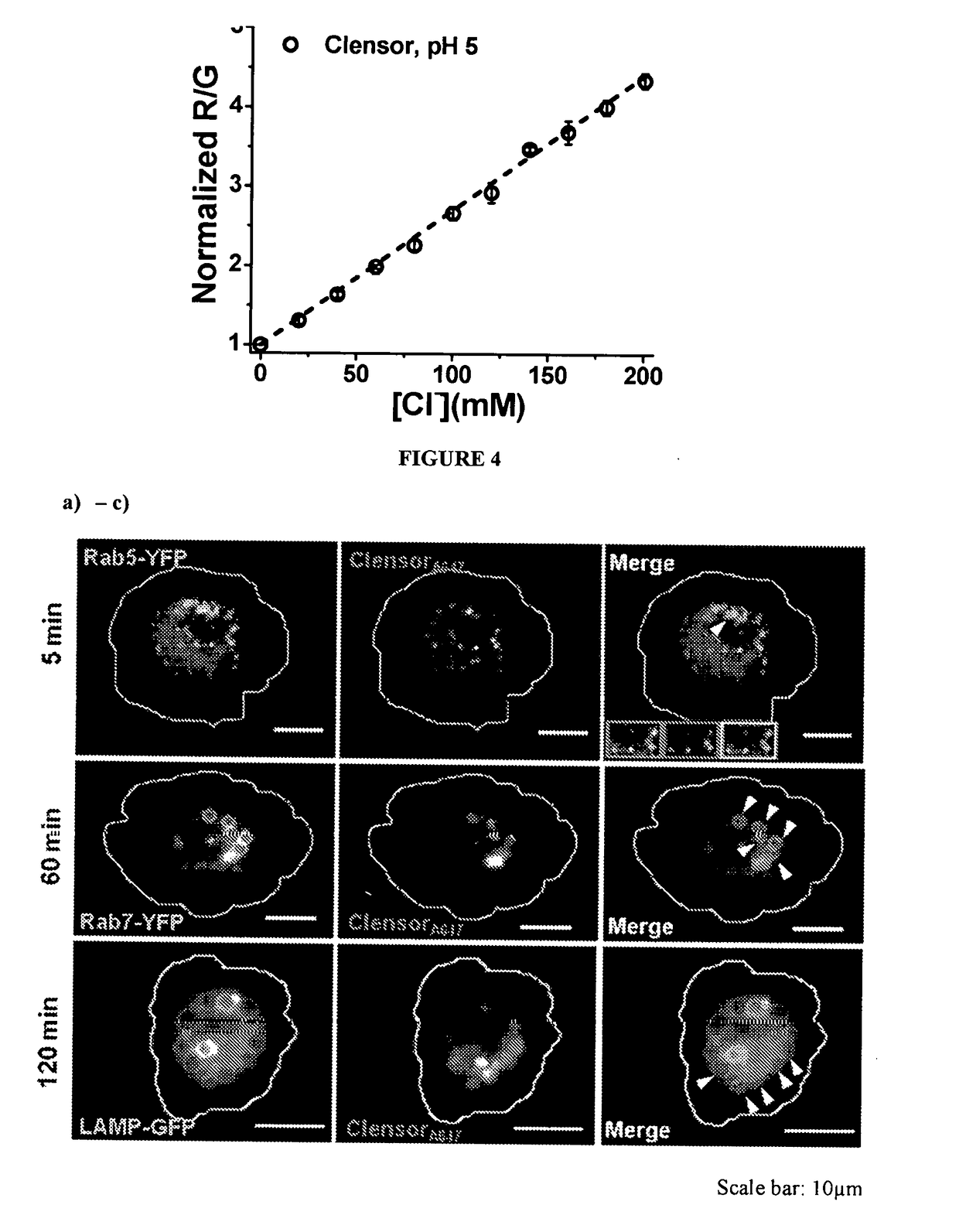Nucleic Acid Based Sensor and Methods Thereof
a technology of fluorescent ratiometric and nucleic acid, applied in the direction of biochemistry apparatus and processes, microbiological testing/measurement, etc., can solve the problem of inability to accurately measure the concentration of lysosomal chloride ions, the role of intracellular chloride in specific pathways is not well elucidated, and the existing strategy is not suitable for designing chloride ion sensors
- Summary
- Abstract
- Description
- Claims
- Application Information
AI Technical Summary
Benefits of technology
Problems solved by technology
Method used
Image
Examples
example 1
odule
[0085]Examples 1A to 1C of the present disclosure relate to preparation of sensing module of the nucleic acid based sensor of the present disclosure. Example 1A provides for preparation of Peptide Nucleic Acid (PNA). Example 1B relates to the target sensitive fluorophore of the sensing module and Example 1C describes the characteristics of Peptide Nucleic Acid as the backbone of the sensing module.
example 1a
n of Peptide Nucleic Acid (PNA)
[0086]In an embodiment of the present disclosure, the sensing module of the nucleic acid based ratio-metric sensor is a peptide nucleic acid (PNA). PNA strands are constructed by standard solid phase synthesis using Fmoc (Fluorenylmethyloxycarbonyl) chemistry in the laboratory. The strand is conjugated to a target sensitive molecule, for ex.: small, fluorescent, chloride ion-sensitive molecule such as BAC (10, 10′-Bis[3-carboxypropyl]-9,9′-biacridinium Dinitrate). However, other target sensitive molecule or chloride ion sensitive small molecule is also used in place of BAC as part of the sensing module.
[0087]Solid Phase PNA Synthesis using Fmoc Method:
[0088]1. Fmoc-Lys(Boc)-NovaSyn® TGA (cat. No. 04-12-2662) is weighed using a dry spatula in a dry unused vac-elute column containing a rice grain magnetic stir bar. The chunks of resin are smashed softly using spatula before weighing. The amount of resin is calculated based on loading.
[0089]NovaSyn® TGA r...
example 1b
sitive Molecule of Sensing Module
[0141]The sensing module of the nucleic acid based sensor comprises of Peptide Nucleic Acid conjugated to a target sensitive molecule. In an embodiment of the present disclosure, in presence of chloride ion, fluorescence of target sensitive molecule or chloride ion-sensitive molecule, such as BAC, which is conjugated to the PNA of the sensing module of the sensor, undergoes collisional quenching.
[0142]BAC fluorescence is linearly dependent on chloride ion concentration in range of about 0 to >120 mM with a Stern-Volmer quenching constant of about 36 BAC fluorescence is insensitive to physiological change in pH and to cations, non-halide anions (nitrate, phosphate, bicarbonate, sulfate) and albumin. Therefore, it is suitable for chloride ion concentration measurement in biological systems.
[0143]In an embodiment, fluorescence intensity data / Stern-Volmer plot is obtained for BAC as follows:[0144]1. 100 mM Sodium Phosphate buffer of pH 7.4 is diluted to ...
PUM
| Property | Measurement | Unit |
|---|---|---|
| pH | aaaaa | aaaaa |
| size distribution | aaaaa | aaaaa |
| pH | aaaaa | aaaaa |
Abstract
Description
Claims
Application Information
 Login to View More
Login to View More - R&D
- Intellectual Property
- Life Sciences
- Materials
- Tech Scout
- Unparalleled Data Quality
- Higher Quality Content
- 60% Fewer Hallucinations
Browse by: Latest US Patents, China's latest patents, Technical Efficacy Thesaurus, Application Domain, Technology Topic, Popular Technical Reports.
© 2025 PatSnap. All rights reserved.Legal|Privacy policy|Modern Slavery Act Transparency Statement|Sitemap|About US| Contact US: help@patsnap.com



